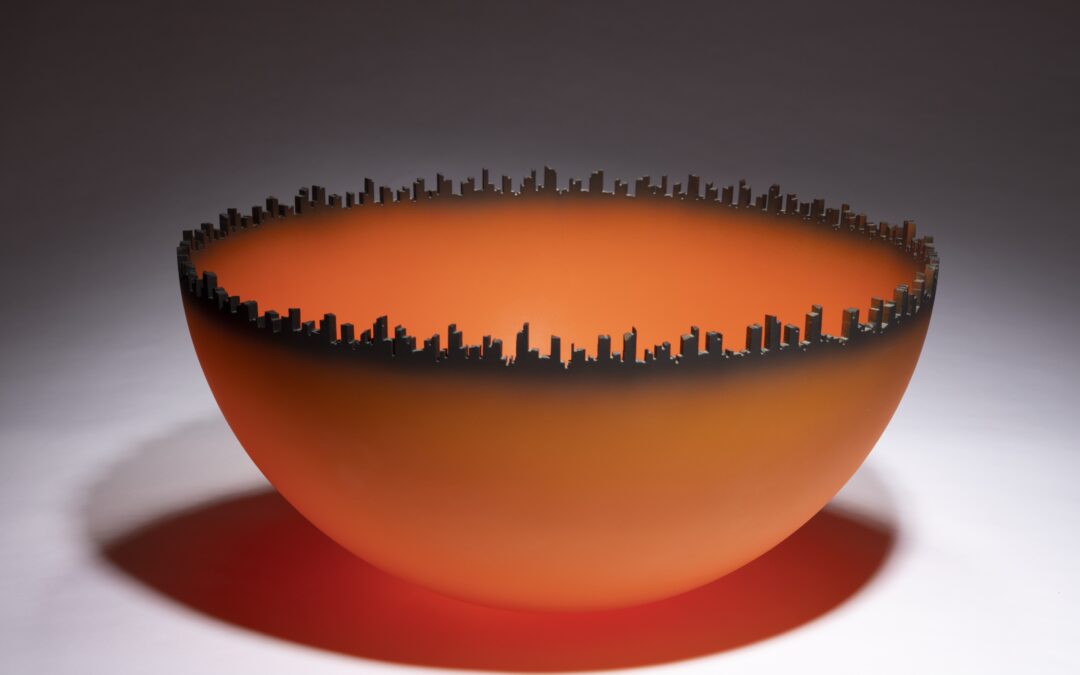By Betsy DiJulio
In 2022, Eddie and Brad Waitzer, directors of the Leah and Richard Waitzer Foundation, together with their brother Scott, generously bestowed upon the Barry Museum of Art their late parents’ collection of works in glass. Not only does the gift pay tribute to the deep friendship between the Waitzers and museum founders, Carolyn and Richard Barry, but it nearly doubles the size of the museum’s glass holdings, helping enable the institution to fulfill its mission of collecting, displaying, interpreting, and researching significant works of art in ever more meaningful ways for generations to come.
Barry founding executive director, Jutta-Annette Page, Ph.D., agreed to emerge from retirement to research and curate the exhibition and author the accompanying hardbound publication. In her introduction to the richly illustrated book, she writes of how the couple used their passion for collecting modern American painting and international glass sculpture in the service of their philanthropy by transforming their home into a showcase where they hosted events in support of causes ranging from medical research to social activism. A photo mural of the work in situ serves to help viewers understand how the Waitzers physically integrated their ever-expanding collection into their suburban home.
Page’s thoughtful and insightful entries for piece after piece in this collection represent a pinnacle of scholarship in the field. In accessible, erudite entries, she creates linkages between and within cultures and canons. Her incisive writing illuminates the artists’ biographies, their processes, and their influences: technical, formal, and conceptual. By probing these artists’ careers and surgically, yet artfully, teasing out key aspects, she reveals deep connections between their art forms and other interests from science and mathematics, to engineering and technology, to anthropology, architecture, and art history. In Page’s adept hands, the story of glass is revealed to be the story of human evolution, shaped as it is by geography and natural resources, economics, politics, philosophy, religion, and, of course, sexuality.
The Waitzers’ immersion in glass collecting was nurtured at the Chrysler Museum which has, since 1971, been home to an internationally acclaimed glass collection. Walter Chrysler, though, was no fan of American studio glass, leaving a hole in the collection that the institution began assiduously working to fill in the 1980s, collecting, educating, and lighting a fire, if you will pardon the pun, under the public and a growing group of patrons in this community. Over the ensuing years, this molten movement catalyzed the Perry Glass Studio at the Chrysler, with the ground recently broken on its major expansion, as well as two major region-wide glass exhibitions (Art of Glass 1 and 2), The Glass Art Society’s international glass conference at the Chrysler, and other academic, artistic, and commercial offshoots.
Among those patrons were the Waitzers who began collecting work ranging from that of Louis Comfort Tiffany at the turn of the 20th century to the present day, and from the East to the West Coast of the US, as well as internationally. The couple took educational tours organized by the Chrysler and traveled on their own with fellow collectors to visit museums and artists in their studios, often returning home with new pieces for their collection, as well as personal connections: a wealth of new knowledge coupled with rich memories.
An art collection is a hybrid organism of artist and patron. So, visitors will encounter evidence of Richard’s legendary sense of humor, as well as the couple’s commitment to the aforementioned medical philanthropy in a piece such as Luke Jerram’s glass interpretation of Swine Flu, part of the artist’s ongoing investigation of infectious diseases.
Monumental pieces by powerhouses like William Morris and Howard Ben Tré confront viewers at the entrance to the exhibition giving way to Tiffany on the left and French florals and more Art Deco-leaning designs to the right. Then its on to mid-century modern Italian pieces, Japanese work, and the American Studio Glass Movement where, as executive director Charlotte Potter Kasic puts it, “artists got hold of glass.”
Names like Harvey Littleton and Ginny Ruffner will be familiar to many, with a household name like pioneer Dale Chihuly well-known to legions more. There are too many highlights to name, but certainly the work of Murano, Italy’s, Lino Tagliapietra, is unsurpassed when it comes to Italian glass-working techniques. Through the maestro’s teaching, his approach to complex, layered patterning and resplendent color has made its way around the globe where it is universally revered.
Clean, crisp, contemporary, and highly formal, the Barry is an elegantly modern, light-infused context for viewing art or simply moving through space. Claude Fixler, exhibition designer at the Toledo Museum of Art and Page’s longtime collaborator, teamed up with his former colleague to carve out stunning integrated spaces with vivid jewel-toned walls in which to peruse just over half of the 165 objects donated to the Barry. To bring the rest of the Waitzer Collection into public view will require a redesign and reinstallation of much of the rest of the museum, a forthcoming project relished by Kasic.
For glass neophytes, a single-fold museum guide explains a dozen glass processes from cameo and caning to sand casting and slumping, each illustrated with an example from the works on view, as well as a baker’s dozen of line drawings and descriptions of tools used by glass artists. Just outside the gallery, a handsome timeline situates the current evolution of glass within its long history with a process sensory station nearby. And in a curved, sunlit space adjacent to the gallery visitors will find the museum’s stylish new Student Lounge and BAM Book Nook whose clean, uncluttered aesthetic is conducive both to solitary research and small meetings.
WANT TO SEE?
PERSPECTIVES: Modern and Contemporary Glass from the Waitzer Collection
Through December 31
Barry Art Museum
757.683.6200




